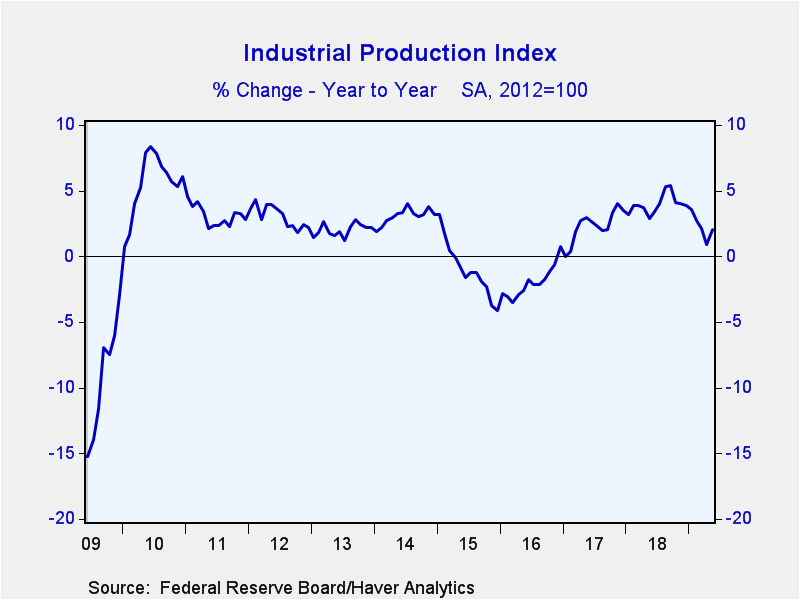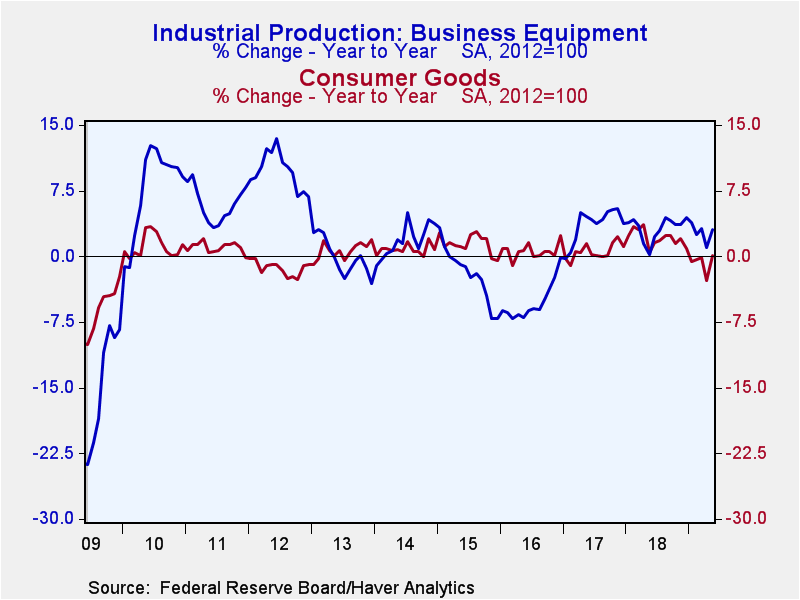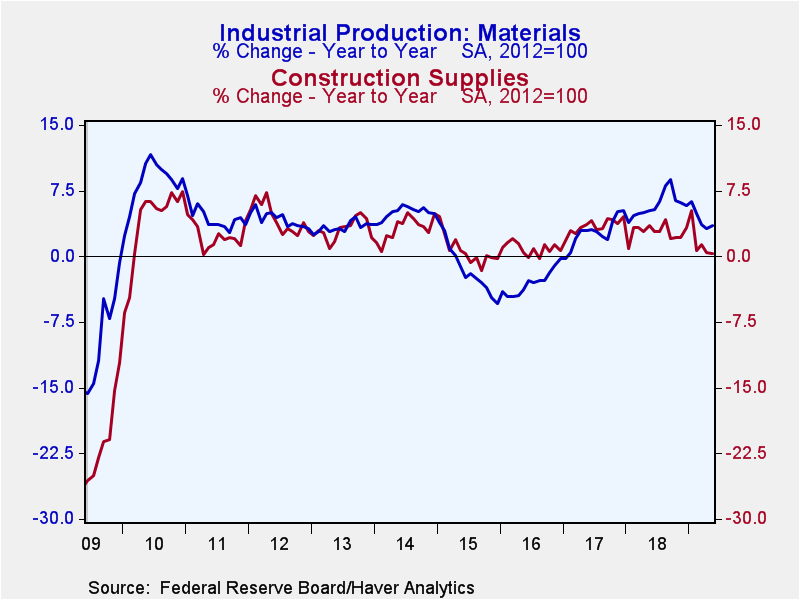 Global| Jun 14 2019
Global| Jun 14 2019U.S. Industrial Production Rebounds
by:Tom Moeller
|in:Economy in Brief
Summary
The industrial sector exhibited life last month. Industrial production increased 0.4% (2.0% y/y) during May and recouped a 0.4% April decline, revised from -0.5%. Output has declined 0.9% since December. A 0.2% increase had been [...]
The industrial sector exhibited life last month. Industrial production increased 0.4% (2.0% y/y) during May and recouped a 0.4% April decline, revised from -0.5%. Output has declined 0.9% since December. A 0.2% increase had been expected in the Action Economics Forecast Survey.
Manufacturing activity recovered 0.2% (0.7% y/y) during May following a 0.5% decline. Output is down 1.5% versus December. Utilities output rebounded 2.1% (0.3% y/y) last month after a 3.1% drop. Mining activity improved 0.1% (10.0% y/y) following a 2.2% increase.
The increase in manufacturing production reflected a 2.0% surge (2.8% y/y) in durable goods output, with motor vehicles production improving 3.4% (5.5% y/y). Appliance, furniture & carpeting production strengthened 1.7% (-2.0% y/y) and production of computers, video & audio products rose 1.1% (15.9% y/y). Nondurable goods output increased 0.1% (-0.7% y/y) as energy product production surged 1.5% (1.4% y/y). Chemical product output gained 0.2% (0.1% y/y, but production of clothing fell 1.4% (-13.5% y/y). Production of food & tobacco products eased 0.6% (-2.2% y/y). Business equipment production rose 0.2% (3.0% y/y) as industrial and other equipment rebounded 1.4% (2.4% y/y) following a sharp April decline. Production of information processing equipment rose 0.3% (5.2% y/y) but transit equipment declined 2.2% (+2.5% y/y).
Construction supplies' output improved 0.2% (0.3% y/y) following a 0.7% decline. Production of materials increased 0.3% (3.5% y/y) after a 0.5% rise.
In the special aggregate groupings, production of high technology products increased 0.3% (6.6% y/y). Semiconductor & electronic components gained 1.1% (7.3% y/y) and communications equipment edged 0.1% higher (17.0% y/y). Output in computer & office equipment declined 1.5% (-0.6% y/y). Factory sector production, excluding the motor vehicle and high tech sectors, held steady (0.1% y/y).
Capacity utilization rebounded to 78.1% in May and made up most of its April decline to 77.9%. Expectations in the Action Economics Forecast Survey called for 78.0%. The factory sector utilization rate rose to 75.7%. Mining sector capacity utilization eased to 91.3%, and remained below December's cycle high of 93.2%. Growth in capacity in the manufacturing sector continues to strengthen, up 1.1% y/y.
Industrial production and capacity data and US Population-Weighted Heating and Cooling Days are included in Haver's USECON database. Additional detail on production and capacity can be found in the IP database. The expectations figures come from the AS1REPNA database.
| Industrial Production (SA, % Change) | May | Apr | Mar | May Y/Y | 2018 | 2017 | 2016 |
|---|---|---|---|---|---|---|---|
| Total Output | 0.4 | -0.4 | 0.1 | 2.0 | 4.0 | 2.3 | -2.0 |
| Manufacturing | 0.2 | -0.5 | 0.0 | 0.7 | 2.3 | 2.0 | -0.8 |
| Consumer Goods | 0.5 | -1.4 | 0.6 | 0.1 | 2.1 | 0.5 | 0.6 |
| Business Equipment | 0.2 | -1.5 | 0.8 | 3.0 | 3.2 | 3.6 | -5.3 |
| Construction Supplies | 0.2 | -0.7 | 0.1 | 0.3 | 2.8 | 3.5 | 0.9 |
| Materials | 0.3 | 0.5 | -0.2 | 3.5 | 5.9 | 2.7 | -3.0 |
| Utilities | 2.1 | -3.1 | 1.7 | 0.3 | 4.4 | -0.8 | -0.4 |
| Mining | 0.1 | 2.2 | -0.4 | 10.0 | 12.4 | 7.4 | -9.9 |
| Capacity Utilization (%) | 78.1 | 77.9 | 78.4 | 78.1 | 78.7 | 76.5 | 75.0 |
| Manufacturing | 75.7 | 75.6 | 76.1 | 76.0 | 76.6 | 75.1 | 74.2 |
Tom Moeller
AuthorMore in Author Profile »Prior to joining Haver Analytics in 2000, Mr. Moeller worked as the Economist at Chancellor Capital Management from 1985 to 1999. There, he developed comprehensive economic forecasts and interpreted economic data for equity and fixed income portfolio managers. Also at Chancellor, Mr. Moeller worked as an equity analyst and was responsible for researching and rating companies in the economically sensitive automobile and housing industries for investment in Chancellor’s equity portfolio. Prior to joining Chancellor, Mr. Moeller was an Economist at Citibank from 1979 to 1984. He also analyzed pricing behavior in the metals industry for the Council on Wage and Price Stability in Washington, D.C. In 1999, Mr. Moeller received the award for most accurate forecast from the Forecasters' Club of New York. From 1990 to 1992 he was President of the New York Association for Business Economists. Mr. Moeller earned an M.B.A. in Finance from Fordham University, where he graduated in 1987. He holds a Bachelor of Arts in Economics from George Washington University.










